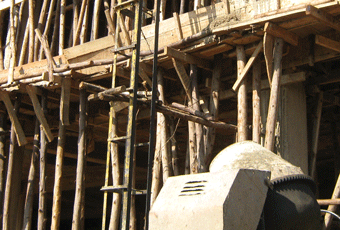
By Patrick Kagenda
Government says 2 new companies coming
The Uganda National Bureau of Standards and ministry of Works Laboratories find no quality problems with it but imported cement from Pakistan has local producers worried.
A combination of rising costs of production, low supply and growing demand pushed the price of common locally produced cement to Shs 30,000 for a 50Kg bag in July. This made the local market attractive for imported cement.
Although the price has since eased slightly to between Shs 28,000 and 27,000, consumers are not celebrating yet because the price difference between the imported cement and the local produce is negligible.
Despite being imported over long distances, however, the imported cement is able to undercut the local in price. A 50Kg bag trades for between Shs 25,000 and Shs 26,000.
Patrick Kaliisa, the sole importer of the cement says it has other advantages.
“In fact the cement is above weight of 50kgs, is manufactured to Islamic weight standards because of the stringent laws in Pakistan, and is very difficult to adulterate,” he said.
In an added blow to local producers, media reports quoted the Minister of State for Trade Gaggawala Wambuzi saying that because local producers have failed to meet local demand, the government is to license two more manufacturers.
If that happens, consumers might get what they are yearning for; good prices.
For now the installed capacity of cement production in the East Africa Community is expected to increase by 124% from 5.8 million tons in 2007 to 13 million tons by 2011. This capacity should comfortably meet the demand for cement in the EAC region with a surplus for export. Cement is a local resource based industry with a high level of domestic value addition.
The East Africa Community member countries removed duty of 15 % on building materials imported into the region during their 2008 annual national budgets. That left 25 % duty on building material imports. At the time when the duty was reduced there was no threat from imports as demand for building materials was strong globally which has since changed. Under the EAC customs union protocol 2005, cement was included in the sensitive product list. The customs duty was agreed to start at 55% (25% CET plus 30% suspended duty) and gradually reduce by 5% every year.
Hima Cement General Manager David Njoroge says local cement producers are hampered by high costs of energy and unreliable infrastructure resulting in costs of cement that are three to five times higher than elsewhere in the world.
“Other competitiveness factors include poor road and rail infrastructure, government subsidies for the importers in their country of production and lower ocean freight rates due to the global meltdown,” he says.
According to him, a kilowatt of electricity costs US cents 12 in Uganda compared to US cents 3 in China, 10 cents in Tanzania and 13 cents in Kenya.
As a result, it is estimated that it costs $115 to produce a ton of cement locally.
On the other hand, clearing agents told the independent, Lucky cement costs $85 cif Dar-es-Salaam. An official of the Tanzania Marine Services office in Kampala said transporting a 40 ton cement container from Mwanza to Portbell is $1,144 which translates to $28.6(Shs 58,630) per ton, while from Dar es Salaam to Mwanza is $63(Shs 129,150) per ton with the dollar rate at Shs 2050. This places the imported cement slightly lower than the locally produced product.
However, local manufacturers suspect importers are incurring lower transport costs. The international recession has reduced demand in Asia and freight costs have fallen correspondingly due to crude oil prices, making exporting easier.
The open East African market has become a sitting target but local producers are calling for government protection.
“The importation of products that are heavily subsidised, are not subjected to the required taxation and do not meet the required national standards in the recipient countries can severely damage the regional economies,” says Njoroge.
“The situation is particularly grim in Tanzania where two of the three companies have suspended production and asked employees to go on leave. Should this situation continue, the same can be expected in Uganda where the cement sector provides direct employment to over 1500 people and indirectly employs over 400,000 people,” he said.
On average the sector contributes about Shs 60 Billion per annum in tax revenue to Uganda government or about 1.2% of projected domestic revenue for the 2009/10 Financial Year. That mean they rake in at least Shs 120 billion in earning before tax annually.
In East Africa the cement sector directly employs over 7,000 people and over 1,000,000 people indirectly.
Meanwhile, Terry Kahuma, the executive director at UNBS says the imported cement is authorised because it passed its batch to batch process.
“So far UNBS has found nothing faulty with the cement,” he said. That leaves the local cement manufacturers strategy crumbling.
 The Independent Uganda: You get the Truth we Pay the Price
The Independent Uganda: You get the Truth we Pay the Price



